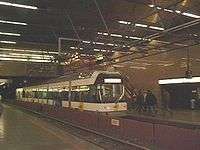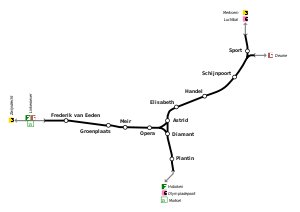Antwerp Pre-metro

The Antwerp Premetro is a network consisting of lines 2, 3, 5, 6, 8, 9 and 15 of the Antwerp Tram system. It is a metre gauge system, which runs underground in the city centre and further out on surface lines, which are separated from motor vehicle traffic. It was intended eventually to evolve into a full metro, similar to the Brussels Metro or German Stadtbahnen (light railways).
History
It was planned at the beginning of the 1970s to build a fully underground network with a length of 15 km and comprising 22 stations. However, due to financial difficulties, only 18 stations have been built. Seven stations built in the late 1980s are unused. The opening of one station (Zegel) is included in the Pegasus Plan. Other stations along the tunnel will not be opened, but an above ground extension will be constructed. The network is now operated by De Lijn.
The first 1.3 km section opened on 25 May 1975 between Opera, Meir and Groenplaats. Further sections were opened in 1980, 1990, 1996, 2006 and 2015. Diamant station was renovated in 2009.
Stations
- Astrid (partly opened in 1996, fully opened in 2015, connecting with the Central station)
- Diamant (opened in 1980, also connecting with the Central station)
- Elisabeth (opened in 1996)
- Frederik van Eeden (opened in 1990)
- Groenplaats (opened in 1975)
- Handel (opened in 1996)
- Meir (opened in 1975)
- Opera (partly opened in 1975)
- Plantin (opened in 1980)
- Schijnpoort (opened in 1996)
- Sport (opened in 1996)
- Carnot (not in use)
- Drink (not in use)
- Zegel (opened in 2015)
- Collegelaan (not in use)
- Morckhoven (not in use)
- Foorplein (not in use)
- Sint-Willibrordus (not in use)
- Stuivenberg (not in use)
The stations Astrid and Opera were originally only partly opened, both having unused platforms unaccessible for travellers. The unused platforms on the -1 level in Astrid station were opened on 18 April 2015 as a part of the opening of the eastern premetro axis (the Reuzenpijp).[1] In 2016, works have started on the renovation and extension of Opera station, as part of the Noorderlijn project. The unused platforms will be put into use upon completion of the renovation and the construction of a premetro entrance on the Leien just south of the station.[2]
Pegasus Plan

In the original plan a route was proposed from the south-western suburbs via Opera and Astrid to the eastern suburbs. A metro tunnel called the Reuzenpijp was built under the Turnhoutsebaan in Borgerhout, as well as some shorter tunnels, as a part of these plans. However, construction stopped in the 1980s due to lack of funds. Although the tunnel itself was largely completed, the stations still had to be decorated and the track still had to be laid.
Under the Pegasus plan (approved in 2004) it was decided to finally open the unused premetro tunnel under the Turnhoutsebaan, although, to reduce the costs of the project, it was decided only to open Zegel station. The stations Carnot, Drink, College and Morckhoven were not opened, but fitted to be used as emergency exits.
More information about the "Sleeping Premetro" in Dutch
See also
References
- ↑ PV Magazine (14 February 2015). "De Lijn viert opening premetrotunnel en 49 jaar premetro" (in Dutch). http://pvmagazine.nl/de-lijn-viert-opening-metrotunnel-en-40-jaar-antwerpse-premetro/.
- ↑ "Noorderlijn: premetrostation Opera" (in Dutch). http://www.noorderlijn.be/premetro-opera.